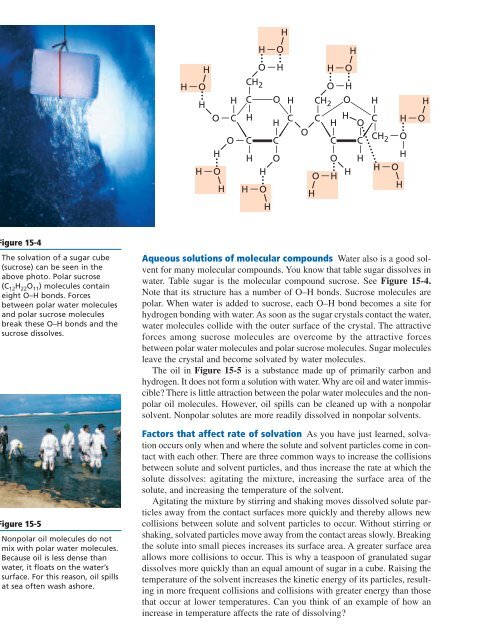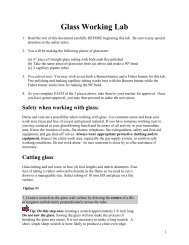Chapter 15: Solutions - Weironline.net
Chapter 15: Solutions - Weironline.net
Chapter 15: Solutions - Weironline.net
You also want an ePaper? Increase the reach of your titles
YUMPU automatically turns print PDFs into web optimized ePapers that Google loves.
Figure <strong>15</strong>-4<br />
The solvation of a sugar cube<br />
(sucrose) can be seen in the<br />
above photo. Polar sucrose<br />
(C 12 H 22 O 11 ) molecules contain<br />
eight O–H bonds. Forces<br />
between polar water molecules<br />
and polar sucrose molecules<br />
break these O–H bonds and the<br />
sucrose dissolves.<br />
Figure <strong>15</strong>-5<br />
Nonpolar oil molecules do not<br />
mix with polar water molecules.<br />
Because oil is less dense than<br />
water, it floats on the water’s<br />
surface. For this reason, oil spills<br />
at sea often wash ashore.<br />
456 <strong>Chapter</strong> <strong>15</strong> <strong>Solutions</strong><br />
H<br />
O — H H — O<br />
H — O<br />
CH2 O — H<br />
H<br />
H C O H CH2 O<br />
O — C H<br />
O — C<br />
H<br />
C<br />
C<br />
O<br />
C<br />
H<br />
C<br />
H<br />
O<br />
C<br />
H<br />
H O<br />
O H<br />
H — O H<br />
O — H<br />
H<br />
H H — O<br />
H<br />
H<br />
—<br />
—<br />
—<br />
—<br />
H — O<br />
—<br />
—<br />
H<br />
—<br />
Aqueous solutions of molecular compounds Water also is a good solvent<br />
for many molecular compounds. You know that table sugar dissolves in<br />
water. Table sugar is the molecular compound sucrose. See Figure <strong>15</strong>-4.<br />
Note that its structure has a number of O–H bonds. Sucrose molecules are<br />
polar. When water is added to sucrose, each O–H bond becomes a site for<br />
hydrogen bonding with water. As soon as the sugar crystals contact the water,<br />
water molecules collide with the outer surface of the crystal. The attractive<br />
forces among sucrose molecules are overcome by the attractive forces<br />
between polar water molecules and polar sucrose molecules. Sugar molecules<br />
leave the crystal and become solvated by water molecules.<br />
The oil in Figure <strong>15</strong>-5 is a substance made up of primarily carbon and<br />
hydrogen. It does not form a solution with water. Why are oil and water immiscible?<br />
There is little attraction between the polar water molecules and the nonpolar<br />
oil molecules. However, oil spills can be cleaned up with a nonpolar<br />
solvent. Nonpolar solutes are more readily dissolved in nonpolar solvents.<br />
Factors that affect rate of solvation As you have just learned, solvation<br />
occurs only when and where the solute and solvent particles come in contact<br />
with each other. There are three common ways to increase the collisions<br />
between solute and solvent particles, and thus increase the rate at which the<br />
solute dissolves: agitating the mixture, increasing the surface area of the<br />
solute, and increasing the temperature of the solvent.<br />
Agitating the mixture by stirring and shaking moves dissolved solute particles<br />
away from the contact surfaces more quickly and thereby allows new<br />
collisions between solute and solvent particles to occur. Without stirring or<br />
shaking, solvated particles move away from the contact areas slowly. Breaking<br />
the solute into small pieces increases its surface area. A greater surface area<br />
allows more collisions to occur. This is why a teaspoon of granulated sugar<br />
dissolves more quickly than an equal amount of sugar in a cube. Raising the<br />
temperature of the solvent increases the ki<strong>net</strong>ic energy of its particles, resulting<br />
in more frequent collisions and collisions with greater energy than those<br />
that occur at lower temperatures. Can you think of an example of how an<br />
increase in temperature affects the rate of dissolving?<br />
—<br />
—<br />
—<br />
H<br />
—<br />
—<br />
H<br />
—<br />
C<br />
CH 2 — O<br />
H<br />
H — O<br />
H<br />
H — O<br />
—<br />
H




